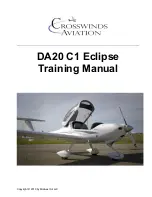
Pre-rotation Procedure
1. Set rotor brake OFF (green indicator light). Verify
full aft cyclic travel.
2. Hold cyclic full forward.
3. Engage and hold wheel brakes FIRMLY.
4. Set pre-rotator ON (red indicator light).
5. Increase throttle to 3000 engine RPM. Once rotor
RPM stabilizes, increase engine RPM to 4000.
6. At desired rotor RPM, set pre-rotator OFF (green
indicator light). This pre-rotation system will
disengage immediately from the rotor head ring
gear, and the belt drive will lock down after about 10
seconds.
7. Verify green indicator lights on both pre-rotator
and rotor brake.
10
Avoiding Rotor Flap
Rotor flap is a dangerous condition that can cause
serious damage to a gyroplane and/or injury to pilot
and passengers. It occurs when the wind introduced
into a gyroplane rotor system causes greater lift in
the advancing blade and greater loss of lift in the
retreating blade than can be offset by the centrifugal
force keeping the rotors level. This allows the
retreating rotor blade to strike the teeter plate on the
rotor head with downward force, spring-loading the
retreating rotor blade. As the blades continue
around, the spring-loaded blade becomes the
advancing rotor blade. It is not only spring-loaded to
rise quickly, but being now the advancing rotor
blade, it also has too much lift, as it was excessive lift
in the advancing blade that started the flap.
A bad rotor flap on a take off roll can easily damage
the tail, cause the rotor to strike the ground or
propeller and even flip the machine over.
Fortunately, it is preventable. If you act quickly when
you first detect a flap, it is very correctable.
A bad rotor flap will jerk the cyclic around with
enough force to cause bad bruises on arms and legs.
At the first sign of a minor bump in the cyclic,
you must act quickly. First, push the cyclic full
forward immediately. Then, reduce the
throttle.
Pushing the cyclic forward sets the rotor
system parallel the earth and thus eliminates the
wind coming through the rotors (that caused the
flap). Reducing the throttle slows the machine down
further. It is a good practice to start your takeoff run
over from the beginning after a flap.
11



























